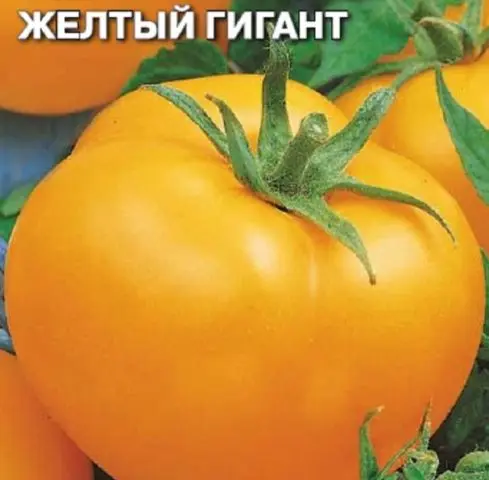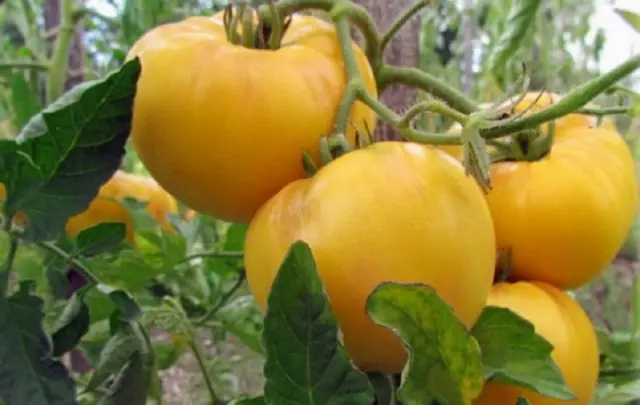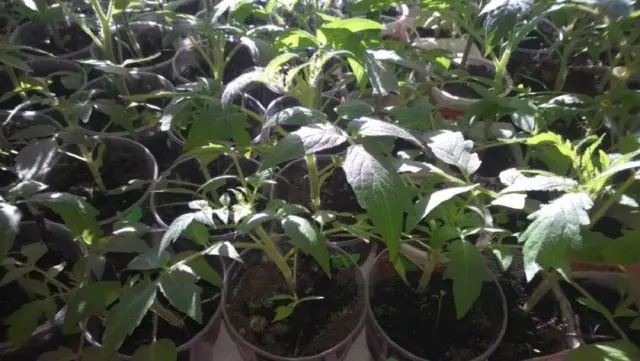Contents
Having its own piece of land, it is often used as a vegetable garden. And if the plot area allows, then you can not only plant different types of vegetables, berries and fruits, but also diversify certain types by planting different varieties. For example, tomatoes have many varieties, some of which are ideal for canning whole, while others are suitable for eating fresh. Having chosen a variety for conservation, you can also plant large-fruited tomatoes. Large-fruited varieties include the Yellow Giant tomato. Its fruits are not only large in size, but also quite sweet in taste.

Detailed description of the variety
The tomato variety Yellow Giant was bred by a group of breeders of the Sedek agricultural company. The plant is indeterminate, the height of its bushes can reach up to 1,7 m, the lash does not end with a flower brush and can continue to grow. The bushes are dense, require pinching and timely garters to the support. The leaves are large, dark green, potato-like. The bush can form 2 stems, while giving up to 10 inflorescences. Up to 6 fruits can be formed on one brush.
Description of fruits
The impressive size of the fruits of the Yellow Giant variety significantly distinguishes it from other varieties of tomatoes. It belongs to the salad type. The fruits of this tomato are large, reaching an average of up to 400 g. The largest specimens were recorded when growing Claude Brown’s Yellow Giant tomatoes with a weight of 700 g to 1 kg.
The color of the fruit is yellow-orange, the shape is uneven, ribbed and flat-round. The pulp is fleshy, quite juicy. On a horizontal section, a large number of small seed chambers are observed, which are filled with liquid and have practically no seeds.
The taste of tomatoes is rich, sweet, with a slight sourness. The peel is thin, easily cut through. The texture of the pulp is pleasant.
Since the Yellow Giant variety tomato belongs to the salad type, it is recommended to use it fresh, for slicing into vegetable salads or for preparing various dishes.
Varietal characteristics
Tomato variety Yellow giant is intended for planting in open ground, but it also takes root well in a greenhouse. The only difference in growing a Yellow Giant tomato in a greenhouse shelter is that the bush can be taller, and the fruits will begin to ripen a little earlier.
Tomato Yellow Giant belongs to mid-season varieties, from the moment of germination of sprouts to the maturation of the first wave of the crop, 110-120 days pass. Fruiting is long – up to 45 days, stable, does not depend on climatic conditions. Tomato takes root in almost all regions, except for the Far North. The highest yields are observed in regions with a warm and sunny climate.
The approximate average yield in open ground from a bush is about 5,5 kg, and from 1 sq. m up to 15 kg.
Resistance to diseases is average, without protective and preventive treatments, bushes and crops can be susceptible to the following types of diseases:
- tobacco mosaic;
- late blight;
- Alternaria;
- downy mildew;
- cladosporiosis.
Among the pests, one can single out the Colorado potato beetle, which carries a special danger precisely to the seedlings of the Yellow Giant variety of tomatoes. But in greenhouse conditions, plants are vulnerable to aphids, whiteflies and thrips.

Advantages and disadvantages
Like all garden plants, the Yellow Giant tomato has its drawbacks and advantages.
The positive qualities include:
- high and long-term productivity;
- unpretentiousness in cultivation;
- fruits are large, beautiful color and rich sweet taste;
- the presence of a large number of microelements in the composition of the fruit, the Yellow Giant tomato variety is especially valued for the presence of niacin, carotene and lycopene in it;
- these fruits are absolutely safe, therefore they are allowed to be used as food for allergies and as baby food;
- the yellow color of the tomato indicates a lower degree of acid, as well as a low calorie content;
- fresh consumption of yellow tomatoes helps to speed up the metabolism in the human body;
- fruit cracking is minimal compared to other large-fruited varieties.
Despite the considerable number of positive properties of the Yellow Giant variety, it also has disadvantages:
- the size of the tomatoes makes them unsuitable for canning as a whole;
- a tall and dense bush takes up a lot of space, so a considerable area is required for planting;
- fruits are not intended for long-term fresh storage, they do not tolerate long-term transportation;
- poor resistance to diseases and pests.
Rules of landing and care
According to the reviews of gardeners and crop photos, you can see that the Yellow Giant tomato has no special rules for planting and caring. The only thing to consider when planting seedlings is that the bushes are quite tall and have dense foliage.
Growing seedlings
Like many varieties of tomatoes, the Yellow Giant is recommended to be planted in seedlings in open ground. Seedlings can be purchased or grown independently. If it is planned to grow seedlings on their own, then Yellow Giant tomato seeds should be taken only from a trusted manufacturer, or you can harvest them from the last harvest. They are harvested only from the largest fruits that have fully ripened on the bush.
Seeds for seedlings must be sown 2 months before the expected date of planting in open ground. Before laying the seeds, they need to be soaked in a weak manganese solution with the addition of a growth stimulator. After soaking, the seeds are dried and placed in a refrigerator for 1-2 days for hardening.
Soil for seeds should consist of peat soil, humus (rotted manure) and sod. In this case, for every 10 kg, you need to add 1 tsp. potassium sulfate, superphosphate and urea. The soil must be well mixed so that the components are evenly spaced.
Before sowing, the soil is moistened and furrows are made on its surface to a depth of 1 cm. A distance of at least 6 cm must be made between the furrows, and 2-2,5 cm between the seeds. Seeds are sown and lightly sprinkled with soil, watering is not required.
For the germination of tomato seeds of the Yellow Giant variety, a favorable temperature is considered to be 22-25 degrees. After the sprouts have sprouted, after about 10-15 days, it is necessary to dive into more fertile soil, into separate pots.

Seedling transplant
The soil of the future beds for tomatoes The yellow giant needs to be prepared since the fall. The soil must be dug up and fertilized. Fertilize the soil in autumn with humus (rotted manure) per 1 sq. m 4 kg.
In the spring, it is also necessary to dig up the soil and add humus again – 4 kg per 1 sq. m, but with the addition of 1 tbsp. l. superphosphate and potassium chloride.
Planting seedlings in open ground should be carried out from mid to late May. At this time, the seedlings should already be about 50-55 days old. But in greenhouse shelters, seedlings can be planted from the end of April.
Landing is carried out in parallel rows or in a checkerboard pattern. The distance in a row between seedlings should be 20-25 cm, and between rows – 60 cm. In a chess planting pattern between seedlings, a distance of up to 40 cm should be retreated, and row spacing should be 50 cm.
After planting, it is necessary to perform preventive spraying with a solution of copper oxychloride (1 tablespoon per 1 liter of water).
Aftercare
Bushes for proper formation need pinching. It is necessary to form a bush in 2 stems to ensure a full harvest.
Watering is required to be carried out as the soil dries, after which it is desirable to loosen to saturate the soil with oxygen.
Top dressing for the entire period of growth and vegetation should be performed at least 3 times:
- The first top dressing is carried out 2 weeks after planting seedlings in open ground. Feed with a solution of 1 kg of manure with 10 liters of water.
- The second top dressing is required after the fruit ovaries on the second brush. It is performed exclusively under the root with a mixture of 1 kg of manure, 3 g of copper sulfate and 3 g of manganese per 10 liters of water.
- The third top dressing is carried out with the same solution as the second, during the period of ripening of the first wave of fruits.
After each top dressing, it is recommended to mulch with a mixture of soil with sawdust, fine straw or pine needles.
Conclusion
Tomato Yellow Giant is ideal for planting if you plan to use the crop fresh. Despite this, many housewives have learned how to preserve tomatoes of this variety, making spicy sauces, tomato juices and various winter salads from them.









